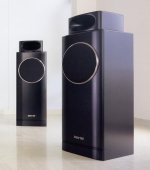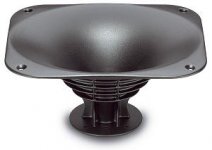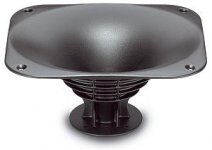gedlee said:
You obviuosly haven't read many Japanese papers. They use forums like this to introduce new products.
well, perhaps, I don't know
but disguised Japanese advertising in 1984 Audio Engineering Society convention paper??! 😉
are You serious?
gedlee said:
Sounds like an advertisment to me.
I ask about this "continuously changing cross-sectional shape" of a horn (http://www.aes.org/e-lib/browse.cfm?elib=4926 )
because it seems to be another solution to the same problem of "HOM" understood as "a sound wave that has reflected inside the horn or waveguide" (a Patrick Bateman's definition that You have agreed to)
the idea of "continuously changing cross-sectional shape" of a horn proposed by Hiroyuki Yoshii in 1984 have been implemented in a couple of commercial designs from Onkyo - non of them is currently available so please don't consider what I write here as an "advertisement" PLEASE 🙂
in the description of Onkyo "Scepter 2002" 1990 loudspeaker at the website of Audio Heritage Japan ( http://audio-heritage.jp/ONKYO/speaker/scepter2002.html ) it is said that the loudspeaker is based on the same Yoshii's waveguide concept as their statement loudspeaker "Grand Scepter GS-1" of 1984 and that the concept is intended to solve the problem of (the site is in Japanese so let me quote a "haiku translation" 😉 from Yahoo! Babel Fish):
the phenomenon which high pass reflects inside horn
(...)
which is called the "multiple pass ghost strain"
"haikuness" of this translation taken apart 😉 it sounds familiar to Your definition of HOM as the "waves that propagate in a waveguide that do not go down the axis, but travel by bouncing off of the walls"
perhaps You are (in Your own words) "the first person to hypothesize the existance" of HOM but Yoshii also was somewhat aware of the problem 20 years ago
and perhaps it is not that (again in Your own words) "with "horns" its not possible to minimize them because you don't know what to do - the equations aren't rigorous enough to predict them so they are simply ignored"
Yoshii proposed a solution
"a" solution, which I cannot judge myself
I don't know - maybe it doesn't work as declared
therefore I ask You (as You have written of Yourself: "Having studied hrons for almost 30 years I think that I have seen just about every conceivable variation")
What do You think of it?
PLEASE be serious, don't answer like "Sounds like an advertisment to me", "You obviuosly haven't read many Japanese papers", "The Japanese forums like this to introduce new products" and so on
the thing was published as an AES paper, comment on it please
You are an expert, I consider You an authoritative source 🙂
after all this is "Geddes on waveguides" - a perfect place to ask such questions
best regards,
graaf
Attachments
graaf said:
after all this is "Geddes on waveguides" - a perfect place to ask such questions
best regards,
graaf
Perhaps this is so, but I don't see where I have the responsibility to drop what I am doing to do a review of every paper that people might want my opinion of. If you send me the paper, and I get the time, I might review it and comment.
gedlee said:
Perhaps this is so, but I don't see where I have the responsibility to drop what I am doing to do a review of every paper that people might want my opinion of. If you send me the paper, and I get the time, I might review it and comment.
I would send it to You but unfortunately I haven't got an acceptable (USA) credit card
I would be happy to refund You 5 USD required from AES members if it is a problem 🙂
because this is not "every paper", it is a "HOM-related" paper, something strictly in the topic of this thread and at the same time something supposedly very rare
best,
graaf
I was under the impression that you have seen all conceiveable variations?gedlee said:
Perhaps this is so, but I don't see where I have the responsibility to drop what I am doing to do a review of every paper that people might want my opinion of. If you send me the paper, and I get the time, I might review it and comment.
soongsc said:
I was under the impression that you have seen all conceiveable variations?
I wonder if there should be a smiley or not 🙄
graaf said:
I would send it to You but unfortunately I haven't got an acceptable (USA) credit card
I would be happy to refund You 5 USD required from AES members if it is a problem 🙂
because this is not "every paper", it is a "HOM-related" paper, something strictly in the topic of this thread and at the same time something supposedly very rare
best,
graaf
If a 24 year old paper were all that significant why didn't anything evolve from it? My 1991 paper changed just about every horn made from that point on. I simply can't see how it could be that significant and unknown. Being that old its very likely that I have read it and simply forgot it. My waveguide papers were in the AES Anthologies Series - the one that you mention didn't.
"Sounds" a bit like XT120/XT1086/XT1464 from 18sound ... anyone have heard any of these?
Magnatar has and has the pair of 120's for sale.He seems to prefer something else now, but I'm pretty sure they aren't bad..
That looks more like a 1086, which I was lusting after, but somewhere on some thread here there is a photo that shows a mold made from the interior of the 1086 and there seems to be a kink (diffractor
 ) in one direction of it. Too bad as I really wanted it. If this is wrong and it is really OK someone please tell me. I THINK that the 120 doesn't have this , but is smaller so doesn't handle as low a frequency
) in one direction of it. Too bad as I really wanted it. If this is wrong and it is really OK someone please tell me. I THINK that the 120 doesn't have this , but is smaller so doesn't handle as low a frequency Lynn Olson bought a pair of 1464's to try with his 1.4" drivers. I suppose someday we will get an opinion from him..
gedlee said:
If a 24 year old paper were all that significant why didn't anything evolve from it?
(...)
I simply can't see how it could be that significant and unknown.
many reasons can be pointed I believe
first of all the Japanese paper concerned a HOM problem - something "simply ignored" (in Your own words) by the mainstream, and moreover - it is still ignored today despite Your publications, isn't it?
gedlee said:
My 1991 paper changed just about every horn made from that point on.
yes indeed but what about Your proprietary technology of this foam HOM "supressor"?
who bought a licence? where can we see it applied in commercial designs?
what will happen to it when You give up?
and this is I believe the second main reason why the Japanese paper was overlooked/ignored/forgotten - it was proprietary Onkyo technology - therefore it was not taken up by others (who reasoned - "why should We pay? we have our own technology and it sells well") and when it was abandoned by the company, perhaps for some economic reasons (typical), it was the end of it
there are other reasons - it was in the pre-internet era and to make things worse the person who might be interested most in the dissemination of the invention that is the inventor himself - Mr Yoshii - fell ill and was forced to withdraw from the business for many years... and so on
gedlee said:
Being that old its very likely that I have read it and simply forgot it.
well, perhaps You have just ignored/overlooked/forgotten it because it had been presented well before You have "hypothesized the the existance of" the HOM problem "for the first time" Yourself?
and even perhaps the man reason was that Japanese speaker designers weren't taken for serious by American audio engineers then? (and they still are not now?)
anyway, I understand that You are interested in the problem of HOM
so - here is something very rare - a research of the problem that You seem to have forgotten/overlooked (?)
yet You seem to be very reluctant to examine it - why?
this I cannot understand
best regards,
graaf
Variac said:Magnatar has and has the pair of 120's for sale.He seems to prefer something else now, but I'm pretty sure they aren't bad..
That looks more like a 1086, which I was lusting after, but somewhere on some thread here there is a photo that shows a mold made from the interior of the 1086 and there seems to be a kink (diffractor) in one direction of it. Too bad as I really wanted it. If this is wrong and it is really OK someone please tell me. I THINK that the 120 doesn't have this, but is smaller so doesn't handle as low a frequency.
I seriously thought about buying these from him, but finally decided to put the project aside and continue focusing on selling all the stuff I have to get rid of. My home and a storage building are full. Anyway, in the process of trying to make a decision, I guess I ended up leaving him hanging. I hope he's not too angry at me. 🙂
Anyway, I'm also still interested in the DDS ENG 1-90. Any thoughts/experiences? My understanding is that it's probably best used around 1500 Hz and up. Is this correct?
Is Dr. Geddes still offering his waveguides? Seems as though all his threads tend to get filled with the usual monotonous belligerence and bickering back and forth, and I can't ever find what I'm looking for. If he is still selling them, I might be interested in buying 2 or 3 soon.
..Just gathering options to consider. In the meantime, I'll be trying to get back a fraction of the money I've wasted in the past..
tinitus said:Makes me wonder what would happen if we added foam/stuffing to other "ordinary" waveguides 🙄
Excellent point.
But I guess Earl knows the answer...
graaf said:yet You seem to be very reluctant to examine it - why?
this I cannot understand
Graaf,
Your attitude is becoming worse and worse. Please stop.
Have you read the paper in question? Apparently not, based on your comments.
As Dr. Geddes pointed out, the paper is largely an advertisement in disguise. The main thrust is that the throat is round (to match the driver) and the mouth is rectangular (to make it look "conventional", as near as I can tell).
They make passing reference to reduced "multi-path ghost distortion", but do not define what it is nor how to measure it. They show an impulse response that is slightly cleaner than the impulse response of some other unspecified horn. That is all.
They *cannot* have been aware of the importance of avoiding diffraction, as the mouth of the horn has very sharp edges.
In short, the paper is a joke. Please stop harassing Dr. Geddes regarding something you know nothing about. Making such unfounded accusations as you have is quite insulting. You owe him an apology.
BHTX said:
Anyway, I'm also still interested in the DDS ENG 1-90. Any thoughts/experiences? My understanding is that it's probably best used around 1500 Hz and up. Is this correct?
From some pics I've seen and the pair I seen in person last week the fit and finish is terrible.
Variac said:
That looks more like a 1086, which I was lusting after, but somewhere on some thread here there is a photo that shows a mold made from the interior of the 1086 and there seems to be a kink (diffractor) in one direction of it. Too bad as I really wanted it. If this is wrong and it is really OK someone please tell me.
I bought a pair recently. The pictures are correct. There's a fairly sharp transition in the horizontal axis, the vertical is smoother. The overall shape transitions from a vertical oval at the throat to a horizontal oval at the mouth.
Whenever anything is added to the fron of the wave path, you can expect loss is detail transients. So it's really a tradeoff whether HOM and the transient details are more improtant for a specific design.tinitus said:Makes me wonder what would happen if we added foam/stuffing to other "ordinary" waveguides 🙄
I plan to mount it on the back of a baffle and round the edge to give a smooth transistion
I may try to mount "speaker-cloth" in between and place some kind of acoustic stuffing behind
I may try to mount "speaker-cloth" in between and place some kind of acoustic stuffing behind
soongsc said:
Whenever anything is added to the fron of the wave path, you can expect loss is detail transients.
So it's really a tradeoff whether HOM and the transient details are more improtant for a specific design.
Well, that has been the "religion" fore as long as I can remember
But I have seen measurements that showed a smoother FR with a "frontgrille"(frame with cloth?) in place than without it
I dont think its a scientific fact that you loose any details with frontcloth ... if the speaker is designed to use it
There are other issues related to a normal speaker with frontgrille with cloth ... such as diffraction problems from the frame
Some have even placed thin toilet paper in front of a tweeter, instead of resistor padding ... is supposed to work ok ... you may also say that you loose detail with tweeter series resistor, you should know that
- Home
- Loudspeakers
- Multi-Way
- Geddes on Waveguides


